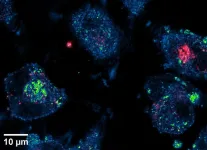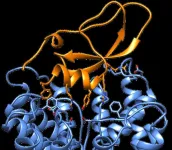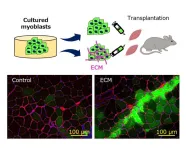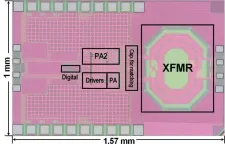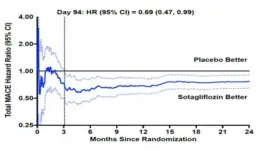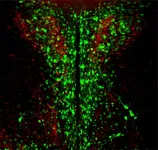Scientists discover "genetic weak spot" in endangered Italian bear population
There are only around 50 Apennine brown bears left in the wild, and new research reveals one reason they may struggle to survive
2025-02-15
(Press-News.org) ROCKVILLE, MD – The Apennine brown bear, also known as the Marsican brown bear (Ursus arctos marsicanus), is a unique and critically endangered subspecies of brown bear found only in the remote and rugged Apennine Mountains of central Italy.
A new study by the Italian Endemixit project (endemixit.com) reveals a potentially critical genetic flaw in the endangered Apennine brown bear population of Italy, offering insights that could help boost conservation efforts. The work will be presented at the 69th Biophysical Society Annual Meeting, to be held February 15 - 19, 2025 in Los Angeles.
This distinct population has been isolated for centuries, evolving unique physical characteristics and behaviors that set it apart from other brown bears. With an estimated population of only around 50 individuals, the Apennine brown bear faces a severe risk of extinction due to habitat loss, human encroachment, and genetic vulnerability. Conservation efforts are crucial to safeguarding this species, which plays a vital role in the delicate ecological balance of its mountainous habitat.
The new research identified a specific genetic mutation within mitochondria – the "powerhouses" of cells – that impairs the bears' cellular energy production, potentially impacting their overall health and survival.
The mutation is in the ND5 subunit of Respiratory Complex I. And using a combination of advanced computer modeling and laboratory experiments, the researchers found that this mutation disrupts the function of mitochondria, leading to reduced energy production and increased harmful byproducts like reactive oxygen species. It’s like a factory with a broken generator: it produces less power and more pollution.
"This mutation appears to significantly impact these bears," explained Nunzio Perta, a graduate student in the lab of Daniele Di Marino at the Marche Polytechnic University, in Ancona, Italy. "It's like they're constantly running on low batteries. This could make it harder for them to survive, especially in a challenging environment."
But because they’ve noted that the bears make more reactive oxygen species as a result of this mutation, other researchers are now exploring ways that they might help the bears process these harmful byproducts. One way to do that, Perta explained, is by helping them eat more food with antioxidants in it, perhaps by planting more native berry plants in their habitat.
"By understanding the molecular basis of these genetic problems, we hope to create a plan to protect these bears in their natural environment,” said Perta. He added, “the bears are a crucial part of the very unique ecosystem that we have here in Italy.”
Image Caption:
Apennine brown bears have a specific genetic mutation within their mitochondria – the "powerhouses" of cells – that potentially impacts their overall health and survival. Image courtesy of Nunzio Perta.
###
The Biophysical Society, founded in 1958, is a professional, scientific Society established to lead development and dissemination of knowledge in biophysics. The Society promotes growth in this expanding field through its annual meeting, publications, and committee and outreach activities. Its 7,000 members are located throughout the United States and the world, where they teach and conduct research in colleges, universities, laboratories, government agencies, and industry.
END
[Attachments] See images for this press release:

ELSE PRESS RELEASES FROM THIS DATE:
2025-02-15
ROCKVILLE, MD – Brain inflammation, while a crucial part of the body's immune response, takes on a detrimental role in Alzheimer's disease. Unlike the acute, short-lived inflammation that combats infection, the inflammation associated with Alzheimer's becomes chronic and persistent. Scientists have been trying to understand why this happens.
New research reveals key differences in how the brain's immune system responds to the disease compared to a bacterial infection. The work will be presented at the 69th ...
2025-02-15
ROCKVILLE, MD – In a surprising discovery, scientists have found that the heart possesses "sweet taste" receptors, similar to those on our tongues, and that stimulating these receptors with sweet substances can modulate the heartbeat. This research opens new avenues for understanding heart function and potentially for developing novel treatments for heart failure.
While taste receptors are traditionally associated with the tongue and our ability to perceive flavors, recent studies ...
2025-02-15
ROCKVILLE, MD – Viruses, like those that cause COVID-19 or HIV, are formidable opponents once they invade our bodies. Antiviral treatments strive to block a virus or halt its replication. However, viruses are dynamic—constantly evolving and changing shape, which can make designing antiviral treatments a challenge.
But new research utilizes an innovative computational modeling approach to capture the complex and diverse shapes that viral proteins can adopt. The work will be presented at the 69th Biophysical Society Annual Meeting, to be held February 15 - 19, 2025 in Los Angeles.
This new approach, implemented in the open-source Integrative Modeling Platform ...
2025-02-15
ROCKVILLE, MD – When scientists develop new molecules—whether for the purposes of agriculture, species control, or life-savings drugs—it’s important to know exactly what its targets are. Thoroughly understanding a molecule's interactions, both intended and unintended, is crucial for ensuring its safety and efficacy.
A cone snail toxin known to affect both insects and fish inspired Weizmann Institute scientists to develop a new way of finding molecular targets. By combining artificial intelligence with traditional ...
2025-02-15
Tokyo, Japan – Researchers from Tokyo Metropolitan University have developed a way to treat ageing-related muscular atrophy using regenerative medicine. Conventional methods to implant myoblasts, precursors to muscle fiber, required prior scarring for the new cells to graft properly. By adding extracellular matrix (ECM) fluid into the implant, the team successfully grafted myoblasts onto healthy muscle in mice. Their technique opens the way for using implantation to treat unscarred muscle atrophied by ageing.
Age-related muscular atrophy in skeletal muscle can have a devastating impact on people’s quality ...
2025-02-15
Three innovative design techniques substantially enhance wireless transmitter performance and can boost power efficiency and elevate data rates concurrently, as reported by the researchers from Science Tokyo, Japan. This effectively aligns with the growing demand for speed and efficiency, accelerating the widespread deployment of wireless devices. This enables synergistic operation of wireless electronic devices and better quality of modern life.
Background:
Integrating artificial intelligence (AI) into everyday life requires the interconnectedness of all electronic devices via a technology called the Internet of Things (IoT). The rapid expansion of the IoT market has ...
2025-02-15
The clownfish-anemone living arrangement is one of the most widely recognized examples of symbiosis. Researchers have made a breakthrough in understanding how anemonefish can live safely among sea anemones without being stung by their venomous tentacles, solving a century-long mystery.
Scientists at the Okinawa Institute of Science and Technology (OIST) and their international collaborators have discovered that anemonefish have evolved to maintain very low levels of sialic acid in their skin mucus to avoid triggering the release of nematocysts (stinging cells) in ...
2025-02-15
Sotagliflozin, a drug recently approved by the Food and Drug Administration to treat type 2 diabetes and kidney disease with additional cardiovascular risk factors, can significantly reduce heart attack and stroke among these patients, according to results from an international clinical trial led by a Mount Sinai researcher.
Sotagliflozin is a sodium-glucose cotransporter (SGLT) inhibitor. It blocks the function of two proteins, known as SGLT1 and SGLT2, which move glucose and sodium across cell membranes and help control blood sugar levels. Other SGLT2 inhibitors do not as significantly block SGLT1.
The study, published ...
2025-02-14
PROVIDENCE, R.I. [Brown University] — Scientists discovered years ago that the hypothalamus — which helps to manage body temperature, hunger, sex drive, sleep and more — includes neurons that express the protein opsin 3 (OPN3). Far less clear, however, was what this light-sensing protein does so deep inside the brain.
A study published in PNAS suggests that OPN3 plays an important role in regulating food consumption.
“Our results uncover a mechanism by which the nonvisual opsin ...
2025-02-14
New blood test could improve Alzheimer’s Disease diagnosis, research finds
Up to half of all people living with Alzheimer’s Disease in Ireland remain undiagnosed. Now, a new blood test may have the potential to transform patient care, allowing for better diagnosis, earlier interventions and more targeted treatments.
Researchers at Trinity College Dublin, the Tallaght Institute of Memory and Cognition and St James’s Hospital, Dublin are exploring the ability of a new blood test, plasma p-tau217, to detect Alzheimer’s Disease (AD). This test could potentially replace the current diagnostic method, a lumbar puncture/spinal tap (which ...
LAST 30 PRESS RELEASES:
[Press-News.org] Scientists discover "genetic weak spot" in endangered Italian bear population
There are only around 50 Apennine brown bears left in the wild, and new research reveals one reason they may struggle to survive

